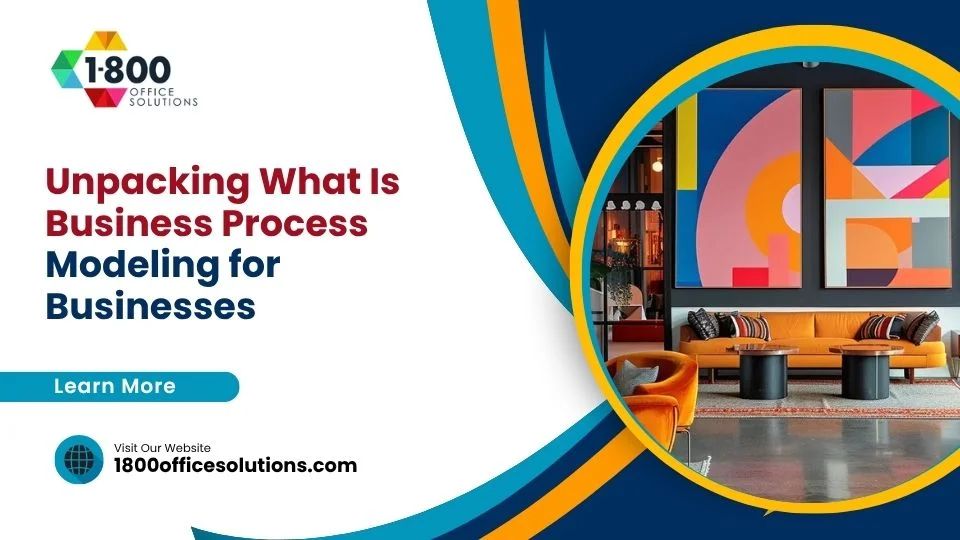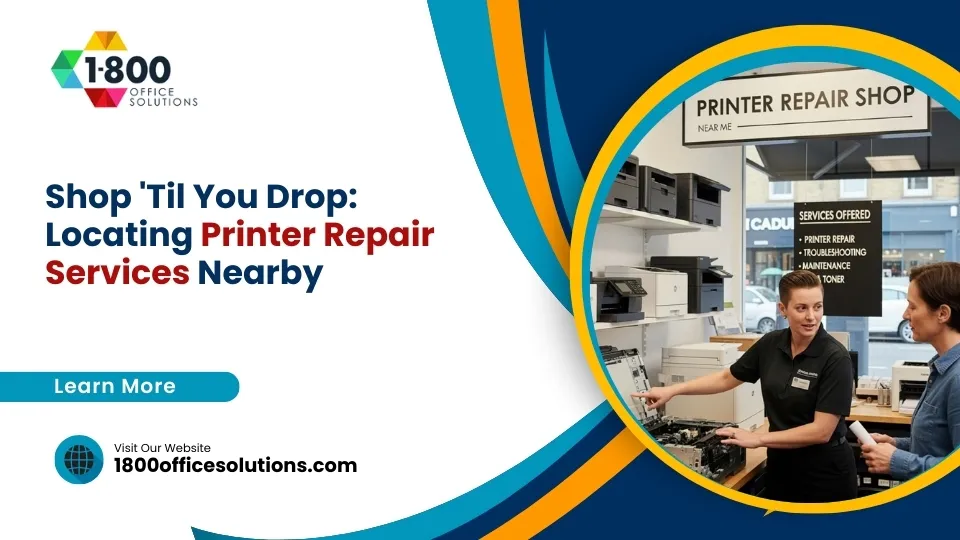Everything You Need to Know About Monochrome Printing
Monochrome printing might sound old-fashioned, but it’s actually one of the smartest business decisions you can make in 2024. With many offices unknowingly wasting thousands of dollars annually on unnecessary color printing, understanding this cost-effective alternative could transform your bottom line.
Here’s what you need to know about monochrome printing:
- Definition: Printing using only black ink or toner on white paper
- Cost: Around $0.03 per page vs. $0.15+ for color printing
- Speed: Faster than color printing for text documents
- Best for: Reports, contracts, invoices, and text-heavy documents
- Savings potential: Up to $14,400 annually for offices printing 10,000 pages monthly
The numbers tell the story. Color printing can use up to 20 times more ink than monochrome printing, yet most business documents don’t actually need color. Legal firms, healthcare offices, and accounting departments have finded that monochrome printing delivers the professional appearance they need while slashing operational costs.
The confusion factor: Many people mix up monochrome with grayscale printing, or assume it means sacrificing quality. In reality, modern monochrome printers produce crisp, sharp text that’s often more readable than color alternatives.
For tech-savvy office managers dealing with tight budgets and demanding productivity goals, monochrome printing offers a perfect solution – proven technology that works reliably while keeping costs predictable.
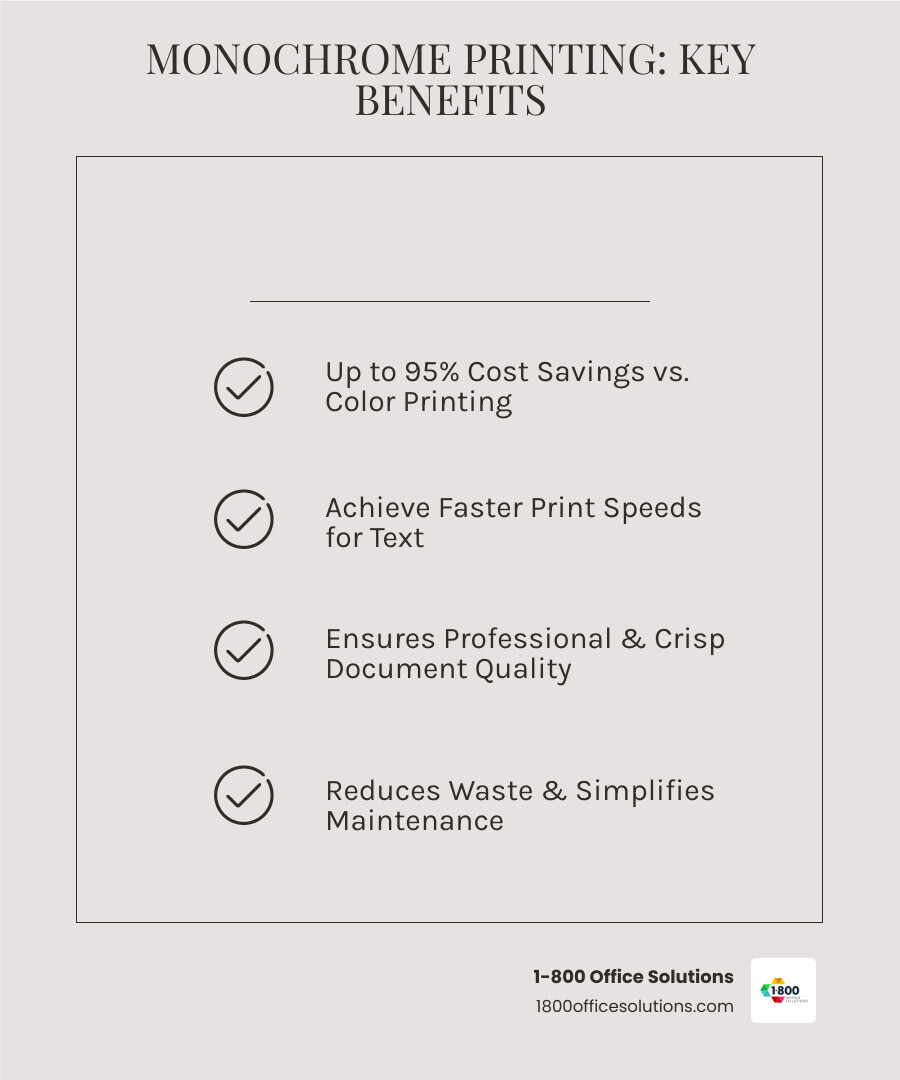
Simple monochrome printing glossary:
- what does monochrome mean in a printer
Monochrome Printing in 2025: Key Trends, Benefits & Savings
What is Monochrome Printing? A Closer Look
If you’ve ever wondered what exactly monochrome printing means beyond the simple “black and white” explanation, you’re not alone. This printing method has more nuance than most people realize, and understanding these distinctions can help you make smarter decisions for your office.
The Core Concept of Monochrome Printing
Monochrome printing is beautifully straightforward – it uses a single color (almost always black ink or toner) to create text and images on white paper. But here’s what makes it special: this simplicity delivers incredibly sharp text and high contrast that’s perfect for professional documents.
Think about the last contract you signed or report you read. Chances are, that crisp, clean appearance came from monochrome printing. The technology focuses all its energy on perfecting that one color, resulting in text that’s easier to read than many color alternatives.
What surprises many business owners is how reliable this single-cartridge approach becomes. You’re not juggling multiple ink levels or dealing with color calibration issues – just consistent, professional output every time.
Monochrome vs. Grayscale Printing: A Critical Distinction
Here’s where things get interesting, and frankly, where a lot of confusion happens. Monochrome and grayscale sound similar, but they work quite differently:
| Feature | Monochrome Printing | Grayscale Printing |
|---|---|---|
| Colors Used | Pure black and white only, uses only black toner | Multiple shades of gray, may mix color inks to create tones |
| Best Applications | Sharp text documents, forms, contracts | Images and photos needing subtle detail |
| Technique | Uses dithering technique (patterns of black dots) for any shading | Creates smooth transitions with actual gray tones |
Monochrome printing creates any gray effects through clever dithering – essentially using patterns of pure black dots to trick your eye into seeing gray. It’s like old newspaper photos, but much more sophisticated.
Grayscale printing, on the other hand, can produce actual gray tones and works better for images that need smooth transitions and subtle details. If you’re printing photographs or complex graphics, grayscale gives you more flexibility.
For most business documents, though, monochrome’s approach works perfectly and costs significantly less.
How Monochrome Differs from Full-Color Printing
The difference between monochrome printing and color printing goes far beyond just the visual result. Color printers use the CMYK color model – that’s Cyan, Magenta, Yellow, and Key (black) – requiring four separate cartridges working together.
Monochrome printing uses just that single cartridge, and this simplicity creates a cascade of benefits. Your lower consumable cost is obvious – you’re buying one cartridge instead of four. But the advantages go deeper.
The faster print process happens because the printer only needs to lay down one color instead of precisely aligning four different ones. We’re talking about significantly higher pages-per-minute speeds, especially for text-heavy documents.
Fewer moving parts means fewer things can break down. Monochrome printers tend to be workhorses that keep running year after year with minimal maintenance. For busy offices in places like Miami, Atlanta, or Philadelphia, that reliability translates to fewer service calls and less downtime.
The energy efficiency is another bonus – monochrome printers typically use less power than their color counterparts, which helps with both your electricity bill and your company’s environmental goals.
The Business Case for Monochrome Printing
When you’re running a business, every dollar counts. That’s exactly why monochrome printing has become such a game-changer for companies across the country. The benefits aren’t just theoretical – they’re real, measurable improvements that show up on your bottom line every month.
Opening up Significant Cost Savings
Here’s where the numbers get really exciting. The difference between monochrome printing and color printing isn’t just noticeable – it’s dramatic. We’re talking about a typical cost of around $0.03 per page for monochrome versus $0.15 or more for color printing. That’s a five-fold difference that adds up faster than you might think.
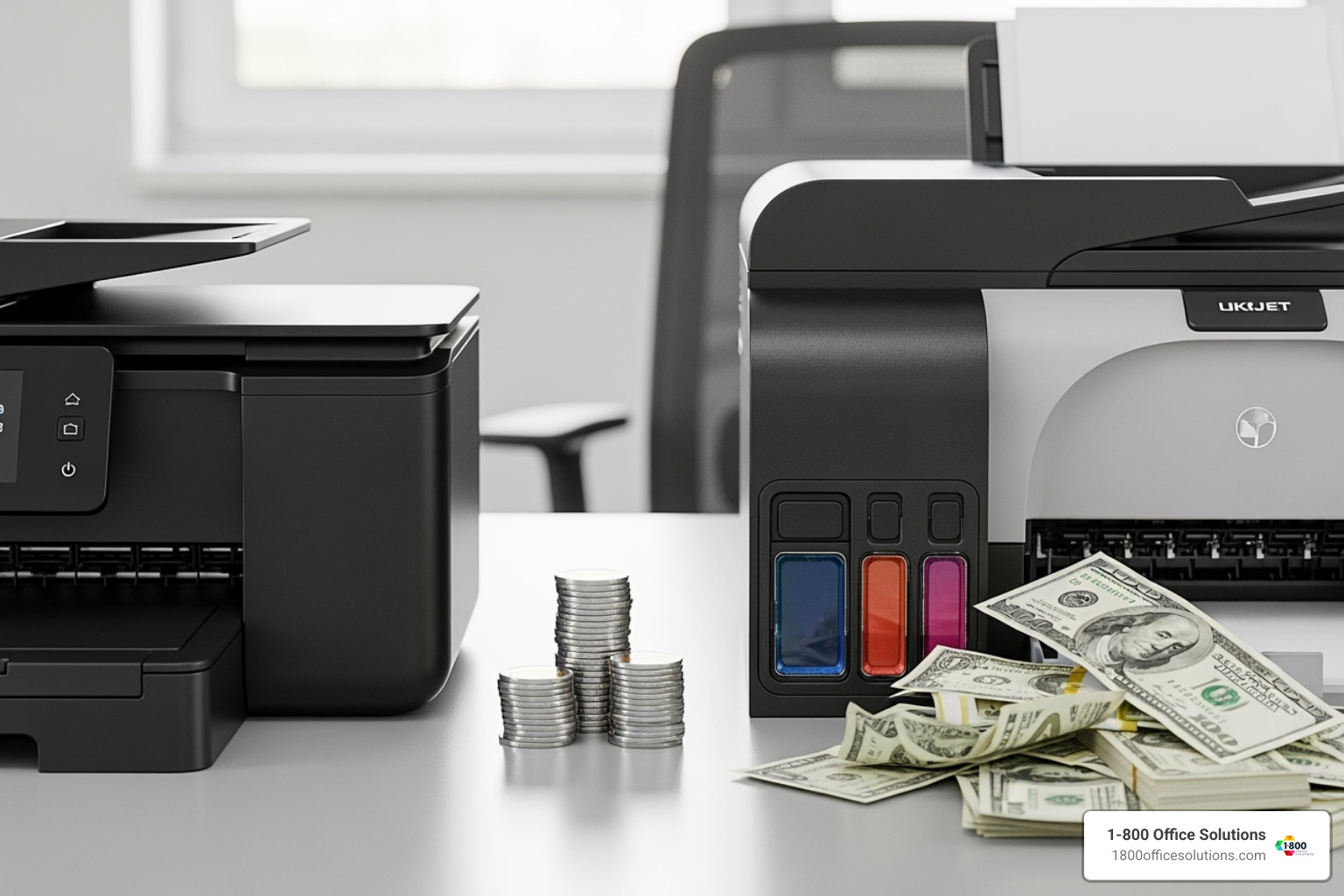
Let’s make this real for your business. If your office prints 10,000 pages monthly – which is pretty typical for most companies – switching to monochrome printing where it makes sense could save you a whopping $14,400 annually. That’s not pocket change; that’s serious money you could invest back into growing your business.
The savings come from several smart advantages. Black toner cartridges typically offer much higher page yields than individual color cartridges, meaning they last longer between replacements. The Total Cost of Ownership also works in your favor because monochrome printers generally use less energy and require less maintenance over time.
We always tell our clients to think beyond the sticker price. A quality monochrome printer might seem like a simple purchase, but its impact on your annual operating costs can be changeal.
Boosting Office Productivity and Speed
Speed matters in business, and this is where monochrome printing really flexes its muscles. These machines are built for performance, with speeds ranging from 30 to over 100 pages per minute. When you’re dealing with contracts, reports, or any text-heavy documents, that speed difference is immediately noticeable.
The productivity boost goes deeper than just raw speed. Monochrome printers have fewer moving parts than complex color systems, which means they’re inherently more reliable. You’ll experience fewer paper jams, less downtime, and reduced maintenance headaches.
For industries like legal, finance, and healthcare – where high volumes of professional documents are the daily norm – this reliability is absolutely crucial. Patient records, financial statements, legal briefs, and administrative paperwork all benefit from the consistent, fast output that monochrome printing delivers.
The simplicity of single-color printing also means these machines warm up faster and process jobs more efficiently, eliminating those frustrating bottlenecks when everyone needs their documents printed right now.
Enhancing Professionalism and Sustainability
There’s something inherently professional about crisp, clean monochrome printing. For contracts, official correspondence, invoices, and formal reports, black-and-white documents convey a sense of seriousness and clarity that keeps the focus exactly where it should be – on your content.
Beyond the professional appearance, monochrome printing aligns perfectly with modern sustainability goals. These printers typically consume less energy than their color counterparts, which translates to lower utility bills and a smaller carbon footprint. You’re also dealing with fewer cartridges overall, which means less packaging waste and fewer empty cartridges heading to landfills.
The environmental impact of printing is something more businesses are taking seriously, and monochrome printing offers a practical way to reduce your office’s environmental footprint without sacrificing quality or efficiency.
For businesses ready to streamline operations while projecting a professional image and being environmentally responsible, monochrome printing represents a strategic advantage. Our managed print services can help you evaluate your specific needs and implement the most cost-effective printing solutions for your operation.
Choosing the Right Monochrome Printer for Your Business
Finding the perfect monochrome printer for your office is like finding the right employee – it’s not just about the lowest price tag. You need a machine that matches your workflow, handles your volume, and grows with your business. Let’s walk through the decisions that matter most.
Laser vs. Inkjet: Which Technology is Best for the Office?
When you’re standing in front of two monochrome printers – one laser, one inkjet – the choice might not be immediately obvious. Both print in black and white, but they’re built for completely different worlds.
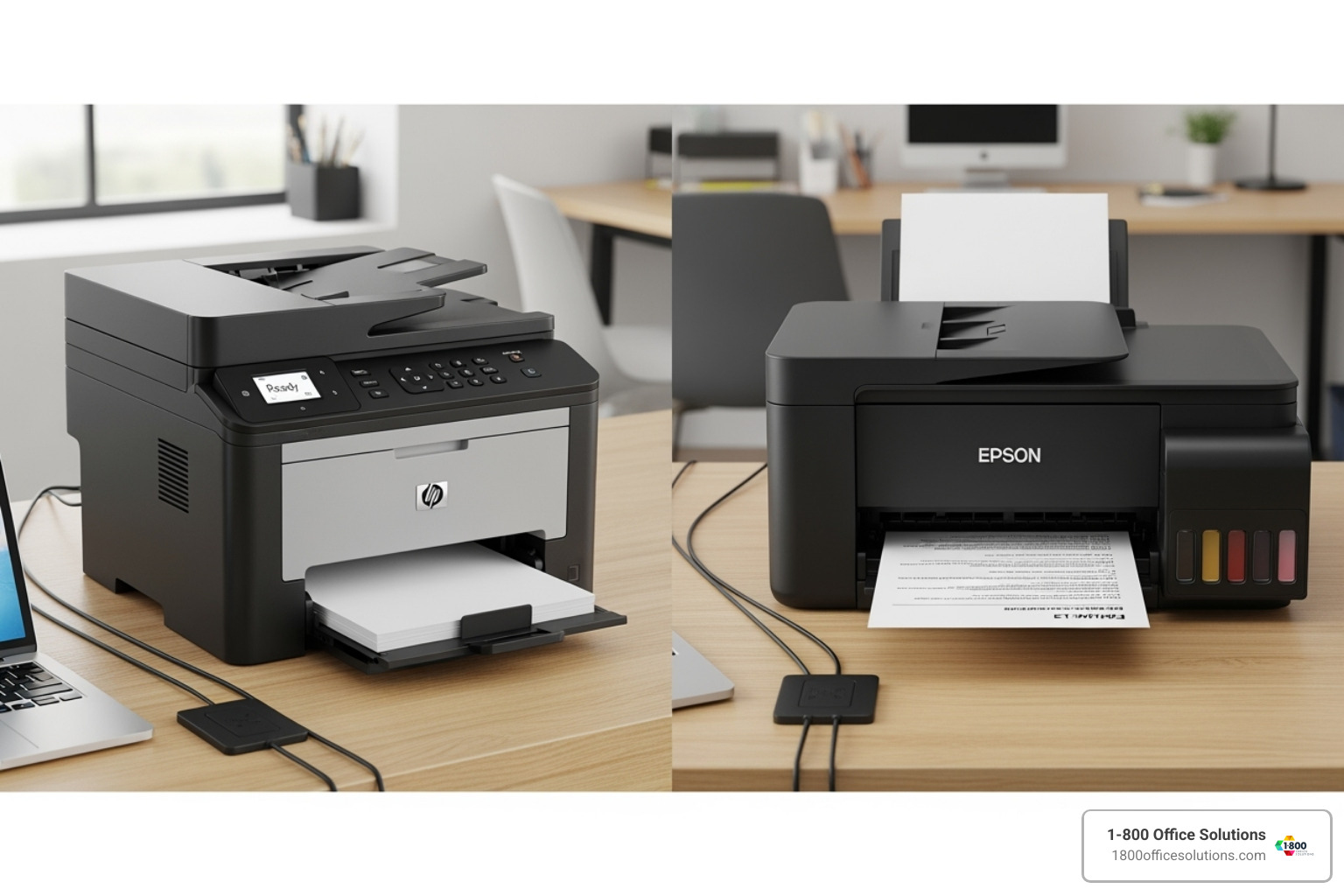
Monochrome laser printers are the workhorses of the office world. They use a laser beam to create an image on a drum, which attracts toner powder that gets fused to paper with heat. Think of them as the reliable pickup truck of printing – built for speed, high volume, and cost-efficiency. If your office prints hundreds or thousands of pages monthly, laser is usually your best friend.
The advantages are hard to ignore: faster print speeds that can reach 50+ pages per minute, lower cost per page for high volumes, incredibly sharp text that looks professional every time, and toner cartridges that never dry out even if you don’t print for weeks. The trade-off? A higher initial purchase cost and typically a larger footprint on your desk or floor.
Monochrome inkjet printers take a different approach, using tiny nozzles to spray liquid ink onto paper. They’re like the compact car of printing – perfect for lower print volumes, small offices, or situations where you need a smaller initial investment. Some specialized monochrome inkjets can even produce stunning black-and-white photos with subtle tonal variations that would make a photographer smile.
The benefits include a lower upfront cost, compact size that fits almost anywhere, and sometimes better grayscale image quality for photos or detailed graphics. However, they come with slower print speeds for text documents, higher cost per page when you’re printing a lot, and ink cartridges that can dry out if your printer sits unused for too long.
For most businesses, especially those printing more than a few hundred pages monthly, we typically recommend monochrome laser printers. The speed and efficiency usually pay for themselves within the first year.
Key Features to Consider in a Business Printer
Once you’ve settled on laser or inkjet, the real decision-making begins. Here’s what separates a good business printer from a great one.
Print speed matters more than you might think. When you’re waiting for a 50-page contract to print, every page per minute counts. Look for printers that can handle at least 30 pages per minute – your future self will thank you during those rush jobs.
Monthly duty cycle is your printer’s endurance rating. If your office prints 5,000 pages monthly, don’t buy a printer rated for 3,000 pages. Give yourself breathing room with a duty cycle that comfortably exceeds your typical volume. It’s like buying a car – you want one that can handle your daily commute without breaking a sweat.
Paper handling capabilities can make or break your daily workflow. Duplex printing (automatic double-sided printing) isn’t just nice to have – it’s essential for saving paper costs and looking professional. High-capacity paper trays mean fewer interruptions to refill paper, which is especially important if multiple people share the printer.
Security features have become non-negotiable for many businesses. Look for secure print release that requires a PIN code, user authentication to track who’s printing what, and data encryption to protect sensitive documents. In industries like healthcare or legal services, these features aren’t optional.
Connectivity options should match how your team actually works. Wi-Fi connectivity gives you flexibility in placement and lets people print from laptops anywhere in the office. Ethernet connections provide rock-solid reliability for high-volume environments. Cloud and mobile printing capabilities let your team print from phones, tablets, or while working remotely.
Don’t forget about operating costs – the hidden expense that can surprise you later. High-yield toner cartridges cost more upfront but deliver better value per page. Some monochrome printers offer “toner saver” modes for draft documents, which can stretch your cartridge life even further.
Can a Monochrome Printer Scan in Color?
This question comes up constantly, and the answer might surprise you. While your monochrome printer will only print in black and white, many models are actually multifunction devices that can scan in full color.
It’s like having a black-and-white TV that can record color shows – the output is monochrome, but the input can be anything. Most modern monochrome multifunction printers come with color scanning capabilities that can digitize documents, photos, or graphics in full color and save them as JPEG, PDF, or TIFF files.
This feature opens up incredibly useful possibilities. Digital archiving becomes effortless when you can scan color documents for storage while keeping your printing costs low. Workflow integration gets smoother when you can digitize any document type without needing a separate scanner. You get the cost-effectiveness of monochrome printing for daily documents while maintaining the flexibility to handle color materials when needed.
For businesses that need to digitize old records, scan color forms, or archive mixed document types, a monochrome multifunction printer with color scanning gives you the best of both worlds – economical printing and versatile digitization in a single device.
Conclusion: Is Monochrome Printing Right for Your Business?
After diving deep into monochrome printing, we’ve uncovered a technology that’s far from outdated—it’s actually a modern business essential disguised as something simple. The evidence speaks for itself, and for most businesses, the answer is a clear yes.
Think about what we’ve finded together. Monochrome printing delivers significant cost savings that can free up thousands of dollars annually for other business priorities. We’re talking about real money—up to $14,400 per year for a typical office—that could go toward equipment upgrades, employee development, or business expansion instead of unnecessary color ink.
The productivity gains are equally impressive. When your team can print reports, contracts, and invoices at lightning speed without worrying about color alignment issues or complex maintenance, work flows smoother. There’s something beautifully straightforward about technology that just works, day after day, without drama.
Reliability becomes your silent business partner. Fewer moving parts mean fewer headaches, less downtime, and more predictable operating costs. Your monochrome printer becomes that dependable team member who shows up every day ready to work.
The professional appearance of crisp, black-and-white documents shouldn’t be underestimated either. There’s an authority and clarity to monochrome printing that color can sometimes muddy. Legal firms, accounting offices, and healthcare practices have long understood this—when precision matters, monochrome delivers.
Even your sustainability goals benefit. Lower energy consumption, fewer cartridges, and reduced waste all add up to a smaller environmental footprint. It’s a win that feels good on multiple levels.

The decision really comes down to assessing your printing needs honestly. If your daily document flow consists mainly of reports, invoices, contracts, memos, and other text-heavy materials where color isn’t functionally necessary, then monochrome printing isn’t just smart—it’s essential for your bottom line.
At 1-800 Office Solutions, we’ve helped businesses across the country make this transition successfully. Our expertise spans from Orlando to Chicago, Atlanta to New York, and we understand the unique printing challenges that different industries face. We’re not just selling equipment; we’re partnering with you to optimize your operations and deliver measurable savings.
Whether you’re ready to upgrade your current setup or exploring options for a new office, we’re here to guide you toward the perfect monochrome printing solution that matches your volume, budget, and workflow requirements.
Ready to take control of your printing costs and boost your office efficiency? Get a commercial copier lease quote today and find how we can help your business thrive with the right printing strategy.
When is monochrome printing the best choice over color?
The sweet spot for monochrome printing is anywhere you need crystal-clear text without the bells and whistles of color. Think about your typical workday documents - those internal reports that get reviewed and filed, invoices that need to look professional but don't require fancy graphics, or legal contracts where every word needs to be razor-sharp and easily readable. We've seen accounting firms slash their printing costs by 80% simply by switching their monthly statements to monochrome printing. Academic institutions love it for textbooks, manuals, and research papers where clarity trumps visual appeal every time.
The rule of thumb? If color doesn't add essential information or significantly impact your message, monochrome printing delivers everything you need at a fraction of the cost. However, when you're creating marketing brochures, client presentations, or documents where your brand colors matter, that's when color printing earns its keep.Do monochrome printers only use black ink?
Here's where the technical definition gets interesting. While "monochrome" literally means "one color" and could theoretically be any single color, in the real world of office equipment, monochrome printers are exclusively designed for black ink or toner on white paper.
You won't find slots for cyan, magenta, or yellow cartridges in these machines - they're built with laser-focused simplicity. This single-minded approach to black-only printing is exactly what makes them so efficient, fast, and cost-effective. It's also why they're virtually maintenance-free compared to their color counterparts.
The beauty lies in this simplicity. When you choose monochrome printing, you're choosing a machine that does one thing exceptionally well, without the complexity that comes with managing multiple color cartridges.
How long do monochrome printer toner cartridges last?
This is where monochrome printing really shows its value proposition. Cartridge lifespan is measured in "page yield" - essentially, how many pages you can print before needing a replacement.
For business-grade monochrome printers, we typically see standard cartridges delivering several thousand pages, but the real game-changers are the high-yield options. These powerhouse cartridges can pump out 8,000, 10,000, or even 15,000 pages before running dry.
What does this mean for your office? Less frequent cartridge changes, lower cost per page, and fewer interruptions to your workflow. We've had clients tell us they went from changing cartridges monthly to quarterly after switching to high-yield monochrome printing solutions.
The actual page yield depends on your specific printer model and how much coverage each page requires, but the numbers are always clearly listed on the cartridge packaging. This transparency makes it easy to calculate your true operational costs and plan your supply budget accordingly.





